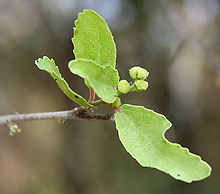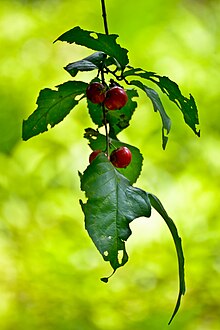Flacourtia
| Flacourtia | |
|---|---|

| |
| Flacourtia indica | |
| Scientific classification | |
| Kingdom: | Plantae |
| Clade: | Tracheophytes |
| Clade: | Angiosperms |
| Clade: | Eudicots |
| Clade: | Rosids |
| Order: | Malpighiales |
| Family: | Salicaceae |
| Subfamily: | Salicoideae |
| Tribe: | Saliceae |
| Genus: | Flacourtia Comm. ex L'Hér.[1] |
| Type species | |
| Flacourtia ramontchi L'Hér.[2]
| |
| Species | |
|
See text | |
| Synonyms[1] | |
| |
Flacourtia is a genus of flowering plants in the family Salicaceae. It was previously placed in the now defunct family Flacourtiaceae.[3] The generic name honors Étienne de Flacourt (1607–1660), a governor of Madagascar. It contains 23 species of shrubs and small trees that are native to the African and Asian tropics and subtropics. Several species, especially Flacourtia indica, are cultivated as ornamentals and for their fruits.[4] The trunks of small trees are often guarded by branching spines.[citation needed]
Species
[edit]As accepted by Plants of the World Online;[1]
- Flacourtia amalotricha A.C.Sm.
- Flacourtia cavaleriei H.Lév.
- Flacourtia degeneri A.C.Sm.
- Flacourtia flavescens Willd.
- Flacourtia helferi Gamble ex Ridl.
- Flacourtia indica (Burm.f.) Merr. – southern Asia, Madagascar[4]
- Flacourtia inermis Roxb. (Batoko plum)
- Flacourtia jangomas (Lour.) Raeusch. – (Indian coffee plum) Tropical Asia
- Flacourtia kinabaluensis Sleumer
- Flacourtia latifolia (Hook.f. & Thomson) T.Cooke
- Flacourtia mollipila Sleumer
- Flacourtia mollis Hook.f. & Thomson
- Flacourtia montana J.Graham
- Flacourtia occidentalis Blatt.
- Flacourtia oppositifolia Gagnep.
- Flacourtia ramontchi L'Hér.
- Flacourtia rukam Zoll. & Moritzi – (Rukam) Indonesia[4]
- Flacourtia subintegra A.C.Sm.
- Flacourtia territorialis Airy Shaw
- Flacourtia tomentella Miq.
- Flacourtia vitiensis (Seem.) A.C.Sm.
- Flacourtia vogelii Hook.f.
- Flacourtia zippelii Slooten
GRIN (United States Department of Agriculture and the Agricultural Research Service) only accepts 5 species; Flacourtia indica, Flacourtia inermis, Flacourtia jangomas, Flacourtia montana and Flacourtia rukam.[3]

Formerly placed here
[edit]
- Xylosma flexuosa (Kunth) Hemsl. (as F. flexuosa Kunth)[3]
References
[edit]- ^ a b c "Flacourtia Comm. ex L'Hér. | Plants of the World Online | Kew Science". Plants of the World Online. Retrieved 26 October 2023.
- ^ "Flacourtia Comm. ex L'Hér". TROPICOS. Missouri Botanical Garden. Retrieved 2010-02-07.
- ^ a b c "GRIN Species Records of Flacourtia". Germplasm Resources Information Network. United States Department of Agriculture. 2006-03-30. Retrieved 26 October 2023.
- ^ a b c Everett, Thomas H. (1981). The New York Botanical Garden Illustrated Encyclopedia of Horticulture. Vol. 4. Courier Corporation. pp. 2376–2377. ISBN 978-0-8240-7234-6.
External links
[edit] Media related to Flacourtia at Wikimedia Commons
Media related to Flacourtia at Wikimedia Commons Data related to Flacourtia at Wikispecies
Data related to Flacourtia at Wikispecies
